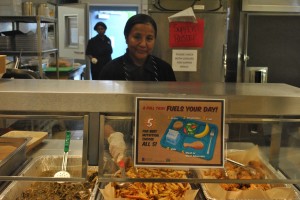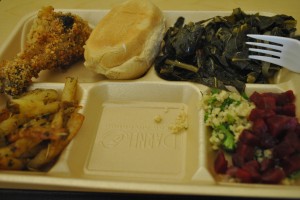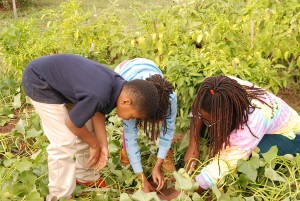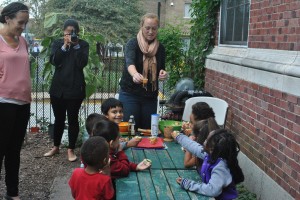Savory, steaming collard greens dished on a lunch plate. Hefty sweet potatoes being plucked from the ground. The pungent aromas of bright green herbs as they’re crushed in a mortar. These were just some of the Farm to School experiences children attending Walker Jones Education Campus and CentroNia Learning Community experienced near the nation’s capital last Thursday. National Sustainable Agriculture Coalition (NSAC) staff visited these educational centers to learn first-hand about Farm to School through a tour organized by the National Farm to School Network and the DC Farm to School Network State Lead Organization, DC Greens.

The visit, which occurred on the second day (October 2) of National Farm to School Month, highlighted how Farm to School not only engages children in a multi-sensory learning experience but how it engages and links schools, non-profit organizations, and federal and local governments to benefit farmers, children, and communities.
The visit also reinforced that strong policies, whether at the local level, such as the D.C. Healthy Schools Act, or at the federal level, such as the 2010 Healthy, Hunger-Free Kids Act and its Farm to School grant program, are critical to developing new and existing farm to school programs.
Walker Jones Education Campus: Comprehensive Farm to School Activities
The visit began with a warm welcome from Helen Dombalis, Policy and Strategic Partnerships Director at the National Farm to School Network, and Karissa McCarthy, Farm to School Director for D.C. Greens, the D.C. Farm to School Lead. The first stop, to enjoy a cooked-from-scratch lunch with second and third graders at Walker Jones Education Campus, located in a predominately African American neighborhood in Northeast Washington, D.C., provided lessons in successfully integrating different farm to school components and in running a successful school meal program.
Running from August to June, Walker Jones Education Campus is a Pre-K through 8th grade D.C. public school with 460 students that provides breakfast, lunch, and supper to its students and has not only locally sourced items incorporated into its school meal program but also has taste tests and school garden activities incorporated into its learning opportunities for students.
As one of 10 DC schools D.C. Central Kitchen (DCCK) has a contract with to provide school meals, Walker Jones is one of the lucky few schools in the area to enjoy mostly-made-from-scratch meals that use ingredients from local farms as a part of DCCK’s Healthy School Food Program. DCCK, a nonprofit “community kitchen” specializing in culinary job training, meal preparation and distribution, and food recycling began its school meal program by serving one private school in the District back in 2008.

Today, DCCK serves 6,300 of its mostly-made-from-scratch meals each day to D.C. students in 8 public and 2 private schools in D.C. over the course of breakfast, lunch, and supper using locally sourced ingredients. The only items that are not made-from-scratch are bread and a few breakfast items, according to DCCK’s School Food Program Manager and registered dietician Katie Nash.
“Thirty to forty or more percent (depending on the season) of meal items are locally sourced, with Walker Jones and other schools served by DCCK on the same menu cycle,” says Ed Kwitowski, Director of School Food Services. Both Kwitowski and Nash were on hand, along with DCCK Chief Development Officer, Alex Moore, to talk about their organization’s Healthy School Food Program and provide a glimpse into the kitchen operations at Walker Jones.
Sourcing from farms in Maryland, Pennsylvania, West Virginia, Virginia, and North Carolina for its cooked meals, DCCK also includes items sourced locally for school salad bars, like the one at Walker Jones. Among DCCK’s biggest sources for fresh, local produce for its meals and catering operations is the Shenandoah Valley Produce Auction in Dayton, Virginia, the largest wholesale auction of locally grown produce and flowers in the state. For DCCK you can “never have too much local. We’re always in search of more local product,” says Nash.
In addition to local procurement, Walker Jones also has taste tests, food demonstrations, theme meals, and cooking classes that teach children important lessons about where their food comes from and how to appreciate new, healthy, and cooked-from-scratch foods. Among the regular taste tests are vegetable taste tests for students that enable students to not only try new foods but to influence what foods they will see in their school cafeteria. The program, known as “Fresh Feature Friday,” began in 2012 and features a different vegetable every month that is prepared three different ways. Kids vote on the item they like, with the winners being incorporated into school menus.
Programs such as Fresh Feature Fridays have been shown to be powerful change agents in helping to develop and reinforce healthy eating habits. In a recent evaluation of four schools conducted by American University to evaluate plate waste in participating schools, researchers found that schools with the Fresh Feature Friday program saw student consumption of local produce items improve significantly.
Farm to school activities, then, reinforce one another, and ultimately help the bottom line of helping kids to develop healthier eating habits and lead healthier lives by improving their awareness and appreciation for healthy food.
K Street Farm: On-Farm Education in Northeast D.C.
The next stop on the tour was to K Street Farm, a one-acre educational school farm located adjacent to the Walker Jones Education Campus, and filled with everything from sweet potatoes and peppers, to the more unusual Turkish figs and shiso herb from Asia.

Managed and maintained by D.C. Greens, a nonprofit organization that helps improve education around and access to fresh and healthy food, K Street Farm is currently a teaching garden for students at Walker Jones and the surrounding community through on-site classes and taste tests of the garden’s various vegetables and fruits. Eventually, D.C. Greens hopes to have K Street Farm’s fresh produce incorporated into the salad bar at Walker Jones.
Managed by DC Greens since the Spring of 2014, K Street Farm has a full-time Food Corps Service member, Miya Nixon, who is available to help Walker Jones students as they make their way through the garden. In an effort to help teachers integrate farm to school into the classroom and expand cooking in the classroom, DC Greens submitted a pending Farm to School grant program application to USDA.
CentroNia: Farm to Pre-School in a Multicultural Environment
About two miles northwest of Walker Jones sits CentroNia, a multicultural community and education center with bi-lingual education classes in the heart of the Columbia Heights neighborhood, a predominately African American and Latino neighborhood in D.C. Lola Bloom, Co-Founder and Co-Executive Director of City Blossoms, a nonprofit organization dedicated to environmental education, community development, artistic expression, and healthy living skills, was on hand to talk about her organization’s work with CentroNia, including with Farm to Preschool. Like Farm to School, Farm to Preschool incorporates school gardening, on-farm visits, taste tests, in-classroom curriculum, and local procurement to help students connect with their food and with agriculture, and learn healthy eating habits, while supporting local farmers.

On this particular visit, a class of about 8 preschoolers were actively participating in a taste test, with City Blossoms instructor, Willa Pohlman, of just picked basil and other herbs from CentroNia’s gardens. The four-to-five year olds were invited to smell, observe, touch, and taste the herbs and encouraged to voice their opinions of the herbs, activities they all enthusiastically participated in. As kids gain more exposure to vegetables in City Blossoms’ workshops, they are able to enjoy them more. For Bloom, having a conversation about vegetables, which is a routine part of farm to school activities, is often “a missing piece” in a typical lunchroom “in getting kids to eat more vegetables.”
The visit concluded with a brief tour with Food and Nutrition Program Director, Beatriz Zuluaga of of CentroNia’s tiny kitchen, where made-from-scratch breakfast, lunch, and snack, often incorporating local ingredients, are prepared each day for over 600 children.
Innovative Local Policies Spurring Innovative Programming
It wasn’t hard to see why CentroNia and Walker Jones were sites featured on the tour and why both had been cited repeatedly as models of what school food and farm to school should look like. What has helped programs like these to take Farm to School activities to the next level have been innovative legislation and policies at the local and federal level that have provided funding and other support.
The 2010 D.C. Healthy Schools Act, for example, created tougher school nutrition and exercise standards, thus requiring more fresh fruit, vegetable, and whole grains in meals, encouraging local procurement, and increasing the amount of time students have to spend exercising.
As D.C. Greens McCarthy explains: “The D.C. law covers a lot of things specific to farm to school. For example, it provides a financial incentive for serving local items. For every local item served, a school receives 5 cents per meal. The Act also provides for a Farm to School Specialist within the D.C. government and sets aside money for farm to school educational opportunities such as farm field trips. Funded through a D.C. soda tax, the Act provides money for school gardens and technical assistance for school gardens and other farm to school activities.”
Bloom from City Blossoms adds: “We and many other local garden- and nutrition-based organizations have benefitted greatly from the Healthy Schools Act.. The funding is structured to support a partner organization with each school, and this has helped us guarantee fee-for-service revenue for our consulting services, which include garden design, curriculum design, professional developments, special events and celebrations, and a workshop series with students and teachers. Also, the support of farm to school programming has improved the landscape of programming in general across the city, and resulted in more trained educators being available as well as many more opportunities for schools to access enrichment activities such as field trips and chefs in schools.”
According to D.C. Greens’ McCarthy, the recently passed Healthy Tots Act extends a lot of the Healthy Schools Act to apply to the pre-K setting, and provides grants for school gardens, field trips, and physical activity.
USDA Farm to School Grant Program At Work
On the federal side, sweeping changes to child nutrition programs were also made in 2010, in the Child Nutrition Act Reauthorization Act (CNR) or the Healthy, Hunger-Free Kids Act of 2010. The 2010 CNR expanded children’s access to nutritious meals and snacks, improved the nutritional quality for school food, supported healthier school environments, and increased nutrition and food system education.
It also funded the USDA Farm to School grant program. The federal grant program provides competitive grants to schools, nonprofits, local agencies, tribal organizations, and farmers to increase local food procurement for school meal programs and to expand educational activities on agriculture and food. The grants can be used for training, supporting operations, planning, purchasing equipment, developing school gardens, developing partnerships, and implementing farm to school programs.
As a 2012 recipient of $100,000 in funding through the federal grant program, DCCK’s Nash says the grant “made a huge difference” in local procurement for its farm to school program. DCCK’s Moore explains that the grant allowed them to purchase equipment for produce washing and processing, which boosted the purchase of local produce by enabling food to be processed, frozen, and stored for use in those months when local produce was not in season.
As a result of an NSAC-coordinated campaign in 2009-10, the program currently has $5 million available to it in annual funding.
However, the program is only currently able to fund a fifth of the applications received. NSAC and the National Farm to School Network are teaming up to to work with Congress to expand that funding base and make other improvements to the Farm to School grant program next year when the Child Nutrition Act is again up for reauthorization.
To stay up to date on the latest in NSAC’s Farm to School Campaign, sign up for our newsletter and action alerts on our homepage.

